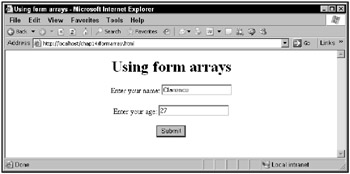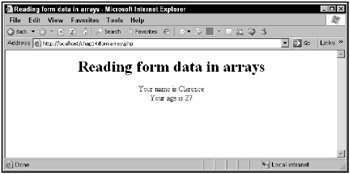Getting User Input in Arrays
It is easy to organize the data sent to you from an HTML form into a single array. For example, say you wanted to ask the user’s name and age. You could store those items in an array named $data, as $data['name'] and $data['age']. You could create those array entries like this in formarray.html:
<html> <head> <title> Using form arrays </title> </head> <body> <center> <h1> Using form arrays </h1> <form method="post" action="formarray.php"> Enter your name: <input name="data[name]" type="text"> <br> <br> Enter your age: <input name="data[age]" type="text"> <br> <br> <input type="submit" value="Submit"> </form> </center> </body> </html>
In formdata.php, you can get the $data array like this:
<html> <head> <title> Reading form data in arrays </title> </head> <body> <center> <h1> Reading form data in arrays </h1> Your name is <? $data = $_REQUEST['data']; . . . ?> </center> </body> </html>
Now you can access the user’s name as $data['name']. Here’s how to do that and get the user’s age as well, echoing them to the browser:
<html> <head> <title> Reading form data in arrays </title> </head> <body> <center> <h1> Reading form data in arrays </h1> Your name is <? $data = $_REQUEST['data']; echo $data['name'], "<br>"; ?> Your age is <? $data = $_REQUEST['data']; echo $data['age'], "<br>"; ?> </center> </body> </html>
You can see formarray.html, with the two text fields, in Figure 14.5.

Figure 14.5: The formarray.html page
In Figure 14.6, you can see the text recovered from those text fields in formarray.php, where the application has been able to read the text from the $data array.

Figure 14.6: The formarray.php application
You’ve gotten some good expertise with PHP now, but each application so far has relied on two pages: an HTML starting page, and a PHP page that handles user input. Can’t you do everything in a single PHP page?